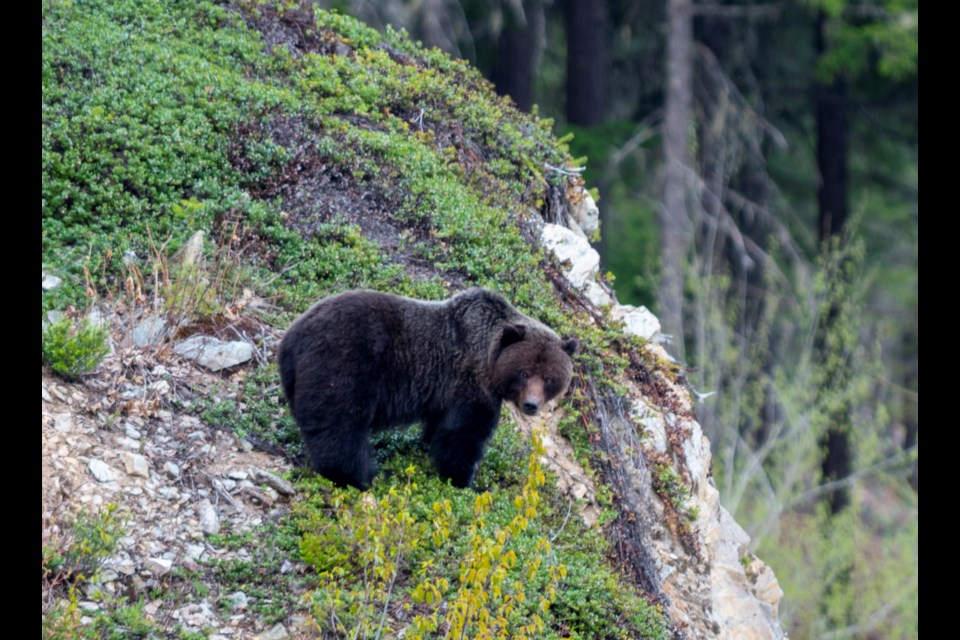A rare grizzly spotted in the Whistler Valley last week could be a sign of things to come, as local populations recover and Whistler’s alpine trail network continue to expand, said a local grizzly expert.
On Thursday, May 11, the Conservation Officer Service (COS) confirmed a grizzly sighting in the area of the Rainbow subdivision, and photos circulating on social media appeared to show the animal roaming through residential backyards. Sgt. Simon Gravel with the COS said there were two firsthand reports of the bear on Thursday, but none since.
While grizzly sightings are rare in the valley, they have been on the rise in recent years—a trend Whistlerites should get used to, according to Johnny Mikes, field coordinator for the Coast to Cascades Grizzly Bear Initiative.
“A grizzly coming down in springtime to find food, we’re seeing evidence of that, and we can probably expect that to continue,” he said. “I think we should be viewing this as a not-very-uncommon occurrence going into the future. People need to plan for that and get their heads around it.”
By Mikes’ estimation, this most recent bear marks only the third recorded grizzly sighting in the Whistler Valley since one was spotted walking through Whistler Cay in May 2020. The sighting is a positive sign of the ongoing recovery of the Squamish-Lillooet grizzly bear population to the west of Whistler, Mikes said.
“The population there, from all indications, is coming back; it is growing. There is no longer a hunt in B.C.; grizzly bears aren’t being persecuted by people, so the numbers are coming back,” he said. “There is also good habitat immediately to the west of us, so those bears are coming back.”
The same can’t be said for the Garibaldi-Pitt population unit east of Whistler, however.
“They are virtually non-existent in that area,” Mikes said. “Over time, we may see bears move across the valley and repopulate some of the habitat around Singing Pass in Garibaldi [Provincial] Park, but we haven’t seen that happen just yet.”
The expansion of Whistler’s Alpine Trail Network, more than 40 kilometres of mountain biking and hiking trails on Rainbow and Sproatt mountains, is another likely factor pushing grizzlies into the valley, as well as adding to the potential for conflict in the alpine.
“We have an issue of an expanding grizzly population combined with a trail network that has expanded into that population, so that’s why we’re seeing more encounters in the summertime up on the alpine trail network,” noted Mikes.
In 2019, the Resort Municipality of Whistler finalized its Grizzly Bear-Human Conflict Mitigation Strategy, alongside the COS and B.C.'s forests ministry, which included recommendations to protect grizzlies in their natural habitat and provide guidance for recreational users in the Alpine Trail Network.
Even still, Mikes called it a “bit unusual” to see a grizzly grazing in someone’s suburban backyard.
“Grizzly bears tend to stay away from people a bit more than black bears, which is a huge generalization, but this bear is obviously not concerned with people,” he said. “It’s very comfortable and it’s not the first place I’d expect to see a bear come down in somebody’s backyard.”
Although grizzlies can be more protective of young and food sources than black bears, many of the same bear-smart practices apply to the two subspecies.
“This serves as a reminder for us all to get into our Bear Smart behaviours,” Mikes noted. “We lose bears every year because people are sloppy and make bad decisions around how they deal with garbage and pet food and whatever else, so we don’t want to have it happen to this bear.”
The public is reminded to keep their pets on leash when out walking, to properly manage garbage and other wildlife attractants, and to maintain a distance of at least 100 metres from bears.
“The key messaging is: it’s spring,” Mikes said. “Spring habitat is at low elevation, and we’re at low elevation. We parked our community here and we need to make sure we’re not incredibly self-centred and anthropocentric in our view of things. It’s a give-and-take and giving all bears some space and us making compromises around our garbage and our practices is something that will be important going forward, whether it’s black bears or grizzly bears.”
Wildlife sightings can be reported to the COS by calling 1-877-952-7277. For more information on mitigating conflict with grizzlies, visit wildsafebc.com/grizzly-bear.




